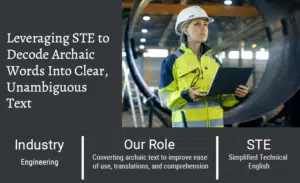
How to Fix The Technobabble Snafu
Technobabble has become so much a part of our lives that we often don’t see the snafus it can create. It is a language unto itself: It is a technical language that is difficult for ordinary people to understand. Technobabble is well-defined as a type of nonsense that consists of buzzwords, esoteric language, or technical jargon. There is little question that technobabble has its place. But the world is changing and the need to communicate information to diverse audiences requires an approach that the entire audience–not just part of it–can understand. Simplified English might be the answer.
A Technobabble Snafu

“Complex technical instructions can be misunderstood and misunderstandings can lead to accidents. STE makes technical texts easy to understand by all readers”
Some Assembly Required
Some Assembly Required is rarely a reason to buy a product and is often a reason to not buy it. The directions may be unclear and likely written in text so small that you have to find the Internet version just to read it. It would be a pleasant surprise if the manual were written in Simplified Technical English that virtually anyone can understand.
Understandable directions, laid out with graphics that actually relate to the product, help to sell it. The fact that a manual can be understood by a broad audience does not diminish the product: It makes it more accessible and more marketable. In fact, any text written so that it can be understood is more engaging and the content is easily understood.
Avoid Your own Technobabble Snafu!
We can help you communicate in Simplified Technical English or just Plain English. Either way, your audience will be engaged in and easily understand your message.
A Technobabble Transformation
A group of engineers were set to update a Code written in the last century. But this would be no easy task because they had no real interest in enabling a wide range of people to crack the Code. Even the promise of protecting the technical integrity of the Code was not appealing. But change was coming so they had to make the best of it. Ultimately, with a few dissenters still unwilling to accept all of the changes, a consensus produced a clear, unambiguous Code. Their story can be downloaded below.
Leveraging STE
Case study of a Simplified Technical English (STE) conversion in the Engineering sector. The conversion was intended to remove the archaic wording and make the text easier to translate and understand. The transformation resulted in reduced cost and better translations.
Translations
Why not just translate the documentation?
For highly technical documents, Simplified Technical English may be more appropriate than Plain Language. The controlled language with its technical dictionaries may better transform these texts into clear, unambiguous documentation. Also, there are times when it is important for all readers to understand the content in English. Once in English, it can be translated into other languages.
“STE was developed to help the readers of English-language documentation understand what they read, particularly when these readers are non-native English speakers.” – ASD-STE100
Translation, however, is not the only consideration here because non-native speakers as an audience is not the only issue. Documentation in simplified English must also bridge the chasm between native speakers who speak English (or any language) well and those who do not. This is especially true for training documentation where everyone from upper management to supervisors to workers must be on the same page. Standard operating procedures, likewise, must be clearly understood by everyone affected by them.
English, Simplified, Might Solve Many Technobabble Snafus
As every business must look for roadblocks that would disrupt their operation, they must also be aware of roadblocks that disrupt communication. Concerns about reducing documentation content to its lowest level of understanding must be replaced by the intent to make information available to the widest possible audience. Simplified Technical English and Plain Language can do just that.
Simplified Technical English
Simplified Technical English
ASD-STE100, also known as Simplified Technical English (STE), is a specification for writing technical documentation in a simplified language that is easy to understand for a global audience.
This can help improve safety, reduce errors, and increase efficiency in various industries where technical documentation plays a critical role.
-Simplifying the Complex: ASD-STE100 (Simplified Technical English)
STE Lanuage Rules
- Restrict sentence length to no more than 20 words (procedural sentences) or 25 words (descriptive sentences)
- Restrict paragraphs to no more than six sentences (in descriptive text)
- Avoid slang and jargon while allowing for specific terminology
- Make instructions as specific as possible
Use articles such as “a/an” and “the” wherever possible - Use simple verb tenses (past, present, and future)
- Use active voice
- Do not use present participles or gerunds (unless part of a Technical Name)
- Write sequential steps as separate sentences
- Start a safety instruction (a warning or a caution) with a clear and simple command or condition.
Before and After Comparison of Plain English Transformation
Before
Traditional RPA are the software programs used for simple tasks that don’t require decision making or cognitive activity. These types of bots are also called rule-based systems as they require a set of rules on how to perform a task, where to log in, what data to collect, and where to transfer it.
In general, robotic process automation refers to rule-based bots, which are good for simple tasks and scaling to thousands of automated processes.
After
Traditional RPA is software programs. These programs do simple tasks. These tasks do not require decision-making activity.
These types of programs are also called rule-based systems. This is because they require a set of rules:
- How to perform a task
- Where to log in
- What data to collect
- Where to transfer data.
In general, robotic process automation refers to rule-based programs that are good for:
- Simple tasks
- Scaling to thousands of automated processes.
Avoid Your own Technobabble Snafu!
As Einstein said, “Everything should be made as simple as possible, but not simpler.” We can help you reach a broad audience without burying the content–and context–of your message.
…in Plain Language
Plain language is grammatically correct and universally understood language that includes complete sentence structure and accurate word usage. Plain language is not unprofessional writing or a method of “dumbing down” or “talking down” to the reader.
Plain English
Writing that is clear and to the point helps improve all communication as it takes less time to read and comprehend. Clear writing tells the reader exactly what the reader needs to know without using unnecessary words or expressions. Communicating clearly is its own reward as it saves time and money. It also improves reader response to messages. Using plain language avoids creating barriers that set us apart from the people with whom we are communicating.
-Office of Personnel Management
Plain Lanuage Rules
- Write for your reader, not yourself. Use pronouns when you can.
- State your major point(s) first before going into details.
- Stick to your topic. Limit each paragraph to one idea and keep it short.
- Write in active voice. Use the passive voice only in rare cases.
- Use short sentences as much as possible.
- Use everyday words. If you must use technical terms, explain them on the first reference.
- Omit unneeded words.
- Keep the subject and verb close together.
- Use headings, lists, and tables to make reading easier.
- Proofread your work, and have a colleague proof it as well.
Before and After Comparison of Plain English Transformation
Before
Right of use means any authorization issued under this part that allows use of Outer Continental Shelf lands. Right of use means any authorization under this part to use Outer Continental Shelf lands.
This rule proposes the Spring/Summer subsistence harvest regulations in Alaska for migratory birds that expire on August 31, 2023. This rule proposes the Spring/Summer subsistence harvest regulations for migratory birds in Alaska. The regulations will expire on August 31, 2023.
This regulation governs disaster assistance for services to prevent hardship caused by fire, flood, or acts of nature that are not provided by FEMA or the Red Cross.
After
Right of use means any authorization under this part to use Outer Continental Shelf lands.
This rule proposes the Spring/Summer subsistence harvest regulations in Alaska for migratory birds that expire on August 31, 2003. This rule proposes the Spring/Summer subsistence harvest regulations for migratory birds in Alaska. The regulations will expire on August 31, 2003.
This regulation governs disaster assistance for services to prevent hardship caused by fire, flood, or acts of nature that are not provided by FEMA or the Red Cross. This regulation governs disaster assistance that:
- Consists of services to prevent hardship caused by fire, flood, or acts of nature; and
- Is furnished by a provider other than FEMA or the Red Cross.
Use Cases for STE and Plain Language?
Simplified Technical English
STE addresses difficulties in English comprehension related to complex sentence structures and the following documentation might benefit the most from using it.
- Information Security Documentation
- Written Information Security Plans
- Standard of Work
- Standard Operating Procedures
- Product Manuals
- User Guides
- Training Manuals
- White Papers
Plain Language (English)
Plain language is communication your audience can understand the first time they read or hear it. A wide range of documentation can benefit from this approach, including:
- Company Reports
- Blog Posts
- Content Writing
- Business Continuity Plans
- Business Case Studies
- Product Manuals
- User Guides
- Employee Handbooks
Why Work With Us?
We are creative, believers in critical thought. Our layouts are sophisticated and appropriate, effective. Our work is informative and engaging. We speak simplified technical English. Let our technical writing services save you time, money, revisions and failed presentations.
Do You Want to Turn Your Technobabble into Unambiguous Clarity?
Let’s Talk

